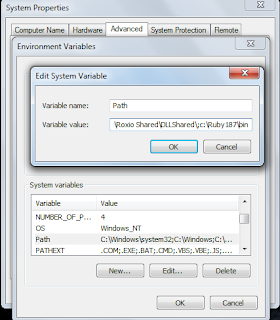Capistrano Deployment in Rails 3 (via the rvm-capistrano gem)
- Go to your project path.
- Add gem 'rvm-capistrano' to your Gemfile
- Run bundle install for installing the gem
- Run the command capify . This will create
- [add] writing './Capfile'
- [add] writing './config/deploy.rb'
- [done] capified!
- Modify the setting in your ./config/deploy.rb, sample settings is provided below
require "rvm/capistrano"
set :application, "My Test App" # Your application name
set :domain, "testapp.com" # Domain name for your app
set :repository, "git@github.com:test/test.git" # The code repository url
set :user, "test_user" # The ssh user that has access to your server
default_run_options[:pty] = true
set :use_sudo, false
set :scm, :git
set :deploy_via, :remote_cache
set :deploy_to, "/home/test/test_project_production" # Server path to which the code is to be deployed
role :web, domain # Your HTTP server, Apache/etc
role :app, domain # This may be the same as your `Web` server
role :db, domain, :primary => true # This is where Rails migrations will run
# Add RVM's lib directory to the load path.
$:.unshift(File.expand_path('./lib', ENV['rvm_path']))
# Load RVM's capistrano plugin.
set :rvm_ruby_string, '1.9.2' # The ruby version in your server
set :rvm_type, :user # Don't use system-wide RVM
# Various task that needs to be executed during the deployment process.
namespace :deploy do
task :start do
run "sudo /etc/init.d/nginx start"
end
task :stop do
run "sudo /etc/init.d/nginx stop"
end
task :restart, :roles => :app, :except => { :no_release => true } do
run "sudo /etc/init.d/nginx restart"
end
desc "Copies database credentials"
task :copy_db_credentials do
run "cp #{shared_path}/credentials/database.yml #{release_path}/config/database.yml"
end
desc "install the necessary prerequisites"
task :bundle_install do
run "cd #{release_path} && bundle install"
end
end
before "deploy:assets:precompile", "deploy:bundle_install"
before "deploy:assets:precompile", "deploy:copy_db_credentials"
# after "deploy:update_code", "deploy:bundle_install"
after "deploy", "deploy:migrate", "deploy:cleanup"
In your ./Capfile uncomment the line load 'deploy/assets'
Now you need to do some configuration in your server:
Now you need to do some configuration in your server:
- Login into the server with root access
- For allowing test_user to run sudo commands without password we need to do the following changes
- Run command: visudo
- Add the following line test_user ALL= NOPASSWD: /etc/init.d/* after
- ## Allow root to run any commands anywhere
- root ALL=(ALL) ALL
- save and exit the file
Now from your local machine project path run the following commands
- cap deploy:setup
- cap deploy:check
- cap deploy
Note: You may get error saying "cannot create releases folder" in server
- Login to your server go to your project path /home/test/test_project_production you will be seeing a "shared" folder create another folder "releases"
- Go to "shared" folder create directories "system", "log", "credentials"
- In credentials folder add your database.yml file with DB settings.
Thats it!!.... Again Run the cap deploy . Your code will be successfully deployed to the server. :)
Helpful links are: Deploying with Capistrano Capistrano Tasks

Comments
Post a Comment